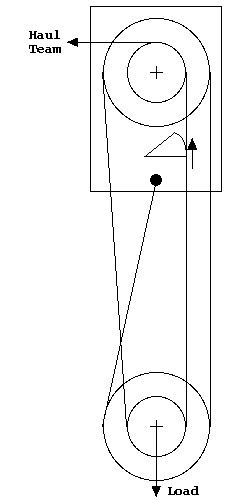Technical Details
 I acquired my RSI Rescue Hauling Pulley from John E. Weinel,
Inc. in 1995.
I acquired my RSI Rescue Hauling Pulley from John E. Weinel,
Inc. in 1995.
The RSI Rescue Hauling Pulley is 227 mm. tall,
78 mm. wide, and 78 mm. thick. Mine weighs 725 g.
The RSI Rescue Hauling Pulley is a double pulley with an eccentric
cam that prevents one strand of rope from leaving the device (unlike
the CMI Uplift and SRT
Rescuemates, which prevent entering). The central frame is
an anodized aluminum extrusion with a rectangular channel for
mounting the cam and an 17 mm. U-shaped channel for the rope.
The channel has the same internal lip that the CMI
5004 ascender has. The cam is a CMI
5003 cam with the CMI safety as well. The cam axle is a pin
secured by an external retaining ring. This makes it easy to replace
the cam when it is worn. A stainless steel cable is attached to
the cam so the cam can be opened remotely. The cable passes over
a safety pin (it also works if passed under the pin) and through
a beveled hole in the frame. Pulling the cable opens the cam.
A safety pin keeps the cam from opening enough to release the
rope, or can be placed in another hole to hold the cam open. There
is a carabiner hole at the bottom of the device.
The
unfinished aluminum pulleys are 45 mm. in diameter. I think
that the front pulley is too small since it allows the rope to
drag on the back of the cam channel under certain situations.
The pulley can handle ropes up to 13 mm. without dragging,
and up to 20 mm. with degraded performance. The pulley side
plates are anodized. The pulley and side plate are riveted to
the frame. The side plate fit tightly without flopping, and the
pulleys turn freely.
Each swinging plate is stamped as follows:
RESCUE SYSTEMS INC.
Rt 2 Box RSI
LITTLE HOCKING, OHIO, 45742
No directions were provided with the device. There is an obvious
way to rig the device for a 4:1 hauling system where the cam supports
one fourth of the load. This is somewhat better than some arrangements
with similar pulleys that have the cam oriented in the opposite
direction.
There is a portion of the rope channel that should have been
rounded, but wasn't. Thirty seconds with a rat-tail file will
fix this oversight. There is also a sharp edge on the side of
the frame that is easily dulled with a file.
Overall, this is a well-made device designed for rescue applications.
Any mechanical advantage system has certain dangers, so it is
important that the team not overstress any components. When rigged
correctly, it is unlikely that this device will be the weakest
link.

For far more content, use a larger monitor and a full-width window.
Hundreds of cell phone users complained and asked me to for a simpler, mobile friendly site. In particular, they wanted me to limit each page to a small number of pictures and minimize my use of text. This new site provides what they asked for.

